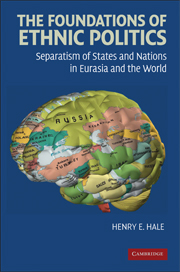1 - INTRODUCTION
Published online by Cambridge University Press: 05 September 2012
Summary
Next to almost every “ethnic hotspot” is another “ethnic spot” that remains conspicuously cool. While Ukrainians and the Baltic republics mobilized in 1991 for independence from the USSR, the Central Asian republics remained bastions of unionism. When Hindu–Muslim riots exploded in the Indian state of Gujarat in 2002, intercommunal peace was the norm in next-door Maharashtra. As Nigeria's Igbo and Hausa-Fulani regions became embroiled in the 1967–70 Biafran civil war, the adjacent Yoruba territory remained relatively calm. And in the international arena, Norway stubbornly kept its distance from the European Union as its neighbor Sweden joined the integrative project in 1995. Even within the hotspots themselves, the heat is not uniform. Some Iraqi villages descend into interconfessional strife while others are more successful at escaping it, and some individuals in Chechnya back independence from Russia while others oppose it. Nor is there consistency over time. The supposedly “age-old enemies” of Yugoslavia, Serbia, and Croatia have been at peace far more often than at war and the same is true with the Hutu and the Tutsi, the groups involved in the tragic Rwandan genocide. Variation such as this constitutes the great puzzle of ethnic politics.
All agree that uncovering the source of such variation is important. The worst ethnic conflicts have killed hundreds of thousands at a time, as has been the case in Yugoslavia, Rwanda, and Nigeria in the last half century.
- Type
- Chapter
- Information
- The Foundations of Ethnic PoliticsSeparatism of States and Nations in Eurasia and the World, pp. 1 - 10Publisher: Cambridge University PressPrint publication year: 2008
References
- 12
- Cited by

